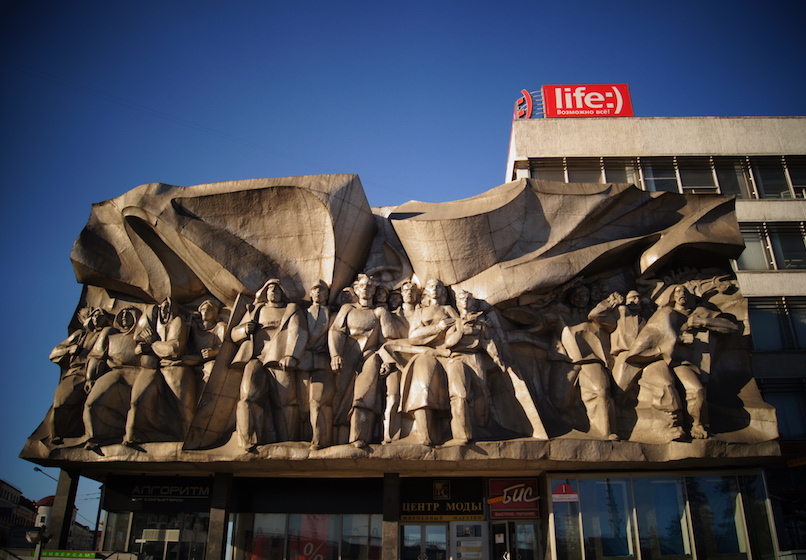Belarus protests: can decentralised media like Nexta bring down Europe’s ailing autocrats?

Traditional media in Belarus has been repeatedly targeted by censorship, harassment, and attacks. Now, a new generation of decentralised news outlets have joined the fray amid major opposition — but new-tech solutions offer just as many pitfalls as perks.
At 6pm on Tuesday 11 August, the Belarusian internet went dark. Internet connections in the country had been sporadic or drastically slowed since Sunday, when Belarus went to elect a new president. State polling predictably suggested that incumbent Belarusian leader, Alexander Lukashenko, who has ruled the country for the past 26 years, would take home another landslide victory — not least due to a leaked audio recording where officials from the Central Electoral Committee appeared to discuss the vote’s pre-planned results.
When the polls closed, however, crowds of opposition supporters took to the streets. They decried brazen vote rigging and another term of Lukashenko’s rule. Riot police came to meet them, often with brutal shows of force. A defining moment in Belarus’ modern history unfolded on the streets.
Yet for journalists, protestors, and human rights groups, Belarus’ internet block has made real time information difficult to access. With limited options, many have been forced to rely on encrypted social media channels that can bypass restrictions, primarily channels on messaging app Telegram. Nexta — a channel which describes itself as the “largest in Belarus, with news, analysis, and inside info” — has come to particular prominence with videos from the protests, as well as practical advice for demonstrators and on-the-ground updates. One of a new breed on decentralised news channels, it is spread across multiple online platforms, rather than on a single website, and relies heavily on anonymous tips and citizen contributions. But as Nexta has opened new doors, it has also posed new questions. Where do these new outlets fit into a modern media scene that is constantly under pressure — and to what extent can they be trusted?
Even if officials have luck in shutting down access to mainstream channels such as YouTube, other platforms remain — particularly Telegram
Nexta was founded in 2015 by 22-year-old Belarusian blogger, Stepan Putilo. Putilo was first active on YouTube, where he uploaded opposition songs onto the Nexta channel. Gradually, he diversified his content and spread to other social media channels, such as Twitter and Instagram. In 2018, Putilo also created a Telegram channel, publishing news as well as “insider tips” submitted by readers. This brand of citizen journalism has continued during the protests, with users sending their own videos and information into the channel for publication.
In many ways, the Belarusian protests have shown the inherent value of organisations such as Nexta. The very nature of the outlet makes it difficult for the authorities to block. Even if officials have luck in shutting down access to mainstream channels such as YouTube, other platforms remain, particularly Telegram, which creator Pavel Durov designed with his own libertarian, pro-privacy principles in mind. Across the border in Russia, authorities tried for more than two years to block Telegram when developers refused to comply with legislation that would essentially require a “backdoor” to be built into the encryption code for authorities to access. The ensuing goose chase saw swathes of the Russian internet being accidentally taken down, and millions of Russians — including government officials — continued to openly use the app. Similarly, even when other outlets in Belarus were blocked, Telegram has largely continued to function. Nexta now has several official channels on Telegram, depending on the kind of updates its readers want to receive.
The police are trying to grab the protesters one at a time. The arrest is followed by severe beating.#ЛукашенкоУходи #LukashenkoGoAway#Belarus pic.twitter.com/NqpjYLXtxq
— NEXTA (@nexta_tv) August 11, 2020
The app allows channel administrators to send images, messages, and text directly to readers’ phones. These can be short messages — “Beware of Gorodetskaya Street, there’s a paddy wagon sitting quietly by number 38” — or longer round-ups closer to traditional news articles of several hundred words, complete with photographs or video. Beaming themselves directly onto readers’ phones, with notifications that appear just like an ordinary WhatsApp message, allows channels to quickly establish an intimate relationship with its readership, which in itself supports a fast-moving, citizen-led stream of news and updates.
This has been vital for news gathering at a time when traditional journalists have become targets of the state. The Belarusian Association of Journalists have listed 62 separate attacks on journalists during the elections so far. Other reporters, including the vast majority of foreign correspondents — traditionally based in Moscow, Prague, and Budapest – have simply had their accreditation to work in the country denied, or are unable to cross the border due to politically-convenient Covid-19 restrictions.
Nexta has also proven popular with users. More than 360,000 people subscribed to the Nexta Live channel in less than 24 hours on Tuesday 11 August.
Interesting background on NEXTA Live, the Telegram channel gaining 100,000s of subscribers a day that is one of the main sources of news out of Belarus at the moment. It’s run by a 22-year blogger living in Poland (Rus)https://t.co/RmMxDQJlY1 pic.twitter.com/gLeKk0M0SP
— Howard Amos (@howardamos) August 12, 2020
Yet decentralised news operations can also pose problems. There is no public information as to Nexta’s funding. This is not unusual for opposition or independent media outlets in the region, with even major news sites such as Meduza keeping its backers under wraps in a bid to stop government forces putting pressure on them. In the post-truth age, such information vacuums can lead to dangerous speculation.
More important to those keeping tabs on the protests however, is the accuracy of the information that Nexta is releasing. Neither Putilo or the channel’s editor-in-chief, 25-year-old Roman Protasevich — formerly a journalist for the likes of the Belarusian edition of Komsomolskaya Pravda — currently in Belarus, but based in Poland. Despite many of its new tech solutions, Nexta is facing many of the same problems as more traditional media outlets: they will need to verify the accuracy of much of its content from afar.
Some will argue that little verification is needed for many of the images or videos that Nexta posts. If an image shows riot police beating protesters, then such pictures should be allowed to speak for themselves. The problem however is that when online manipulation or disinformation comes, it is often subtle. Belarusian government could well feed images to Telegram channels such as Nexta to sow confusion or to later discredit them: perhaps a picture of an injured protestor that state media channels will be gleefully able to prove as staged later on. In fact, Protasevich told news outlet Euronews in an interview that they regularly received incorrect information that they believed to be from the security services.
This lines up with the sloppy “information warfare” that has appeared from the Belarusian government so far: the crude internet blackouts; resolutely cheerful state TV; a video of opposition leader Svetlana Tikhanovskaya filmed under what appears to be heavy duress. A more sophisticated online assault at some point in the future, however, still remains a threat.
Ultimately, there are ways to verify online photos and videos, but these invariably take time. Mostly, this will take the form of matching images with other accounts on the ground. The likes of Nexta may have some advantages: these verifications can be crowdsourced. The channel receives thousands of messages each hour, giving them a “big picture” or an “overview” of the situation that they believe can use to weed out false information. If traditional journalists may have more secure access to certain sources who can greenlight news, the Nexta has pure scale.
“We try to verify using cross-verification,” Protasevich told Euronews. “If several clearly unrelated people write to us and tell us the same thing, then we basically consider this information verified, because we certainly cannot receive any information from officials.” Accounts can also be collaborated via other reporters who continue to risk their safety on the ground — at least when they have the internet to share those reports.
There also other techniques, but these require more practice and a certain eagle-eyed watchfulness. Do certain landmarks or skylines match up with where the image is reported to have been taken? Has the picture been manipulated in any way? Such scrutiny is difficult to implement in a fast-scrolling social media news cycle. But for journalists such as Nexta, it is a barrier that must be overcome. Online, the smallest doubt can breed clouds of confusion, and even a single slip can be fatal. Every reporter faces such pressures, but in Belarus, the stakes have never been higher.
If nothing else, the emergence of decentralised news sites encapsulate many traits of the Belarusian opposition in 2020. They have continued to work and organise, even without a centralised leadership. They have proven themselves to be endlessly creative — protesting with flowers, queues, and the very clothes they wear — and tech-savvy enough to avoid large-scale blackouts.
Going forward, however, will require caution. Sites such as Nexta may be pioneers, but that also condemns them to move in uncharted waters. As they navigate such uncertain seas, it is unlikely that they will not encounter resistance or even outright attacks. Lukashenko has ruled Belarus since 1994 — four years before Nexta founder Stepan Putilo was born. He will not leave office without a fight. For now, real-life violence continues on the streets on Minsk. But a protracted and messy campaign of information warfare, as previously seen in Ukraine, could be brewing on the horizon.


